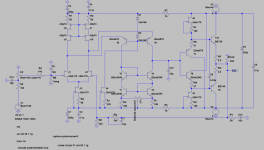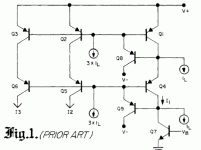PMA said:The best one:
Or not. This topology makes little sense in the context of a discrete design (how would you otherwise provide the MOSFETs W/L sizes and ratios?) and the AC performance is not at all spectacular.
Speaking about integrable circuits, a really good MOSFET current source is described here:
http://www.ecs.soton.ac.uk/publications/rj/1994/micro/balmford/rs.html
For a discrete design, I don't think there's anything beyond the current sources mentioned in this thread. An I certainly doubt anything better than these would be required for audio.
BV said:, sorry, bad picture type
Looks pretty interesting, like always, BV. I guess you have a practical implementation in your power amp, so I'll see it on Saturday?
ostripper said:
Would it not be nice to be able to listen to the output
of LT spiceLt spice w/ headphone jack....
Give me a break.. a compliment will get you much more than an
attack. Like maybe a friend.
OS
actually you can..... LTSpice has a wave file writing function. i think it works something like this
.wave testout.wav 16 44100 V(test)
where .wave is the spice directive
testout.wav or any other filename ending in .wav
16 bits
44100 sample rate
V(tst) or whatever node you are sampling. just make sure your output stays below +/- 1V. use a voltage divider at the amp output. in this case i would have labeled the tap on the voltage divider V(test)
this will write a wave file using the data from the simulation, and you can play it back to see how it sounds. i did this for a fuzz/wah i was designing, and used it to see how the circuit i was designing would sound.
you can even use it to save currents as a wave file.
can the input file be compared to the output, bit by bit?
Sure you can. The result is only the input folded with the transfer function, you can do that also in every decent algebra package. Even with music if you wish.
However why do you want to compare bit by bit? The deviation is in Spice already displayed as spectral function which contains far more information than a bit by bit comparison.
Have fun, Hannes
ostripper said:What graph?
My posts are under moderation and they don't show until approved. It seems I can't attach files now either.
I'm certain I attached it the first time around. I just tried again and it does not show in a preview.
syn08 said:For a discrete design, I don't think there's anything beyond the current sources mentioned in this thread. An I certainly doubt anything better than these would be required for audio.
Well of course this is all academic because in a typical power amplifier the net gain over a basic two transistor mirror would be next to zero.
Cheers,
Glen
G.Kleinschmidt said:
Hardly.
That diode only has potential to make the current mirror linearity worse – in fact I just proved my hunch in LTspice – at 20kHz the LTP non-linearity of a “Blameless” increased significantly (~50%).
It is sub optimal to add a diode in the signal path of a linear circuit like this such that it is forward biased with a current as low as the base currents of the current-mirror transistors.
If you want to better the current mirror by any significant amount then your options are the 4 transistor Widlar or the 3-transistor version attached below. Note the 470-ohm resistor? This ensures high frequency linearity by developing an adequate quiescent emitter current for Q16.
And no, this 470-ohm resistor is not a potential fix for the diode fudge.
Cheers,
Glen
Hi Glen,
You are completely right. The three-transistor current mirror (the extra transistor often being called a "helper") with some pull-down current has been in very common use for many years for these very reasons.
Cheers,
Bob
AKSA, Glen, ..others..
How about a cap around the diode, so it's dynamic impedance becomes low, .. even at low (10uA?) base currents..
Off .. even better (or worse), een resistor instead of the diode to drop some voltage, and a cap around the resistor to lower it's dynamic impedance?....
But maybe then a 'helper-transistor' is simpler, cheaper and easier...?
grtz, nice discussion btw!
How about a cap around the diode, so it's dynamic impedance becomes low, .. even at low (10uA?) base currents..
Off .. even better (or worse), een resistor instead of the diode to drop some voltage, and a cap around the resistor to lower it's dynamic impedance?....
But maybe then a 'helper-transistor' is simpler, cheaper and easier...?
grtz, nice discussion btw!
nelsonvandal said:Can JFETs be used as mirrors? This circuit simulates crazy good.
Unfortunately, matching JFETs (unless you have a secret stash of 2SK389) to the same precision as bipolars is almost impossible. Linear ICs/opamps in CMOS technologies are using such (see the link I posted above), but with MOSFET devices. But, for other reasons, such opamps are usually not good enough for high end audio purposes.
Thanks for your answer. I could have guessed it.syn08 said:
Unfortunately, matching JFETs (unless you have a secret stash of 2SK389) to the same precision as bipolars is almost impossible. Linear ICs/opamps in CMOS technologies are using such (see the link I posted above), but with MOSFET devices. But, for other reasons, such opamps are usually not good enough for high end audio purposes.
Bob Cordell said:
Hi Glen,
You are completely right. The three-transistor current mirror (the extra transistor often being called a "helper") with some pull-down current has been in very common use for many years for these very reasons.
Cheers,
Bob
Thx Bob.
BTW, you should recognise where that schematic snippet I posted came from
Cheers,
Glen
I have just simmed some mirrors in a blameless design to look at some thd results, all results at 20Khz. With the diode I found distortion to be practically the same than a normal mirror, a very very tiny improvement. Glens circuit produced the best results. Glen s circuit also produced better results than the 4 transistor wilson so I take it it will better the 3 transistor one too. Glen s 3 transistor widlar however gave better results without the resistor to the rail, yet again the difference was very small.
Jam, Im starting to believe my preference for the cascoded circuit could be design specific, I was not aiming at THD figures and in that application it sounded better than either a std or wilson 4 transistor mirror, I should try it on another design such as a blameless and compare to other options. BTW the cascoded circuit gave the worst results in the above sims.
Jam, Im starting to believe my preference for the cascoded circuit could be design specific, I was not aiming at THD figures and in that application it sounded better than either a std or wilson 4 transistor mirror, I should try it on another design such as a blameless and compare to other options. BTW the cascoded circuit gave the worst results in the above sims.
that sounds interesting  mlloyd1
mlloyd1
because anyone into no-global-fb, like Charles www.ayre.com Hansen
often needs VERY Precise Current Mirrors
And sometimes, in order to get gains, not only 1:1 mirrors
but current out at a higher ratio, with still high accuracy
I have done a few such designs in my spice (pre- and headphone)
 mlloyd1
mlloyd1because anyone into no-global-fb, like Charles www.ayre.com Hansen
often needs VERY Precise Current Mirrors
And sometimes, in order to get gains, not only 1:1 mirrors
but current out at a higher ratio, with still high accuracy
I have done a few such designs in my spice (pre- and headphone)
Good Morning Glen,
But of course. Diodes distort profoundly and can with great success be used to achieve various unlinear, fuzzy, psychedelic effects, particularly certain types, like germanium, zener and capacitance diodes.It is sub optimal to add a diode in the signal path of a linear circuit That diode only has potential to make the current mirror linearity worse
- Home
- Amplifiers
- Solid State
- Current Mirror Discussion

